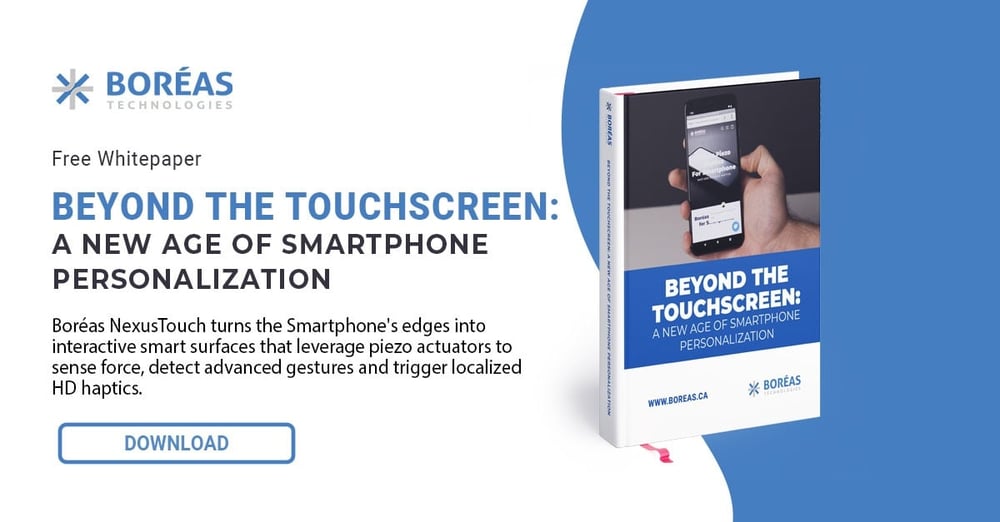
With the release of the first iPhone using system haptics instead of physical buttons, phone users were stunned by the new technology and how it could transform their interaction with their phones. With time, we've learned that haptics provide vibrational feedback that can be just as or more satisfying than pressing a physical button. Today, we're so accustomed to the tactile feedback of haptic buttons some people find it uncomfortable to press the home button on older phone models.
Unlike a mechanical or physical button, a haptic "button" is a virtual object, which will allow you to use software to optimize the user experience even more. Examples of haptic functions that an iPhone user would commonly use include pressing on an app on the screen to move or delete it or accessing the flashlight from the locked screen.
Now, it's time to discover how haptic buttons can reshape the cell phone gaming world.

How Haptic Buttons Work
Haptic feedback uses touch to communicate with a user, primarily through vibrations, motion, and the perceived application of force. It recreates the sense of physically pushing a button when you are instead pressing into a hard surface.
These buttons are valuable tools with a wide range of uses. For example, they interact with other technology, like hand controllers, eye-tracking systems, and voice commands, to actively recognize and respond to user inputs.
The button distinguishes between the two general types of touches, passive and active. Passive touch is light and occurs almost absentmindedly, such as turning a page in a book or tapping your desk while you work. On the other hand, active touch is a conscious action, letting the brain know about a specific piece of information.
The system uses built-in rules and algorithms to identify which type of touch occurred and returns specific feedback to the user. After pressing a button, feedback reaches the user almost immediately, letting them know that it registered their input.
Why Your Cell Phone Needs Haptic Buttons
If you're a mobile gamer with a phone that doesn't use haptic buttons, you may be missing a vastly improved experience. Haptics improve your gameplay and enhance your engagement. Once you try an electronic device with build-in haptics, you'll immediately notice the following benefits:
1. Better Control Through Haptic Feedback
The responsiveness of haptic buttons improves control. Since they provide a feedback force, the user knows instantly if their press registered or if there was a mistake.
Moreover, with practice, they will learn how strongly to press the button to register a passive and active touch, allowing the player to fine-tune their actions to gain more control over their activity.
Players can also customize the haptics on their gaming phone according to the control method that makes their experience feel the most comfortable and intuitive.
2. More Immersive User Experience
In the past, games have often only provided an experience through sight and sound. Haptic buttons let gamers access a third sense: touch. This additional form of sensory feedback increases the immersion level for users.
The ability to differentiate between pressure levels immerses users further, letting the force they put on the haptic surface dictate the response. By associating lower-effort actions with a passive touch (normal pressure) and higher-effort or more intense actions with an active touch (strong pressure), haptic feedback technology trains players to understand the weight behind the force of their touch actions.
Users can also customize the haptic feedback to get the experience they like most. For instance, if they feel the tactile feedback they get isn't strong enough, they can increase the intensity until it suits them.
3. Converts Phone Into a Controller
With the success of the mobile gaming market, the smartphone has become everyone's most convenient gaming console. By incorporating a haptic experience, you can also transform a smartphone into a cell phone gaming controller.
For instance, companies are now offering a different type of trigger button that acts like the triggers on console controllers. These buttons provide localized haptic feedback when a player presses a trigger, mimicking reality, except the phone doesn't need to use bulky trigger buttons that add to its weight.
Players can also customize the haptic touch with software to turn the phone into a perfect controller, unique for each game they play. They could disable some buttons for games that don't need them and adjust their feedback intensity depending on the game's genre. For example, they may prefer less intense feedback for a turn-based strategy game than they would want in an action game.
4. Responds To Pressure Along With Touch
A regular button only has two modes: pressed and unpressed. Lightly or forcefully pressing it won't change the input. However, since haptic feedback technology differentiates between passive and active touch, different amounts of pressure can create different outcomes.
5. Reduces Latency in Response Time
With the best industry technology available now, haptic buttons can capture input within a millisecond or less.
Since haptics give users additional input, they can respond quicker and more accurately to stimuli. For example, in a combo-based fighting game, haptics provide more intense feedback when they land a strong punch rather than a light punch. Therefore, the player can input the appropriate controls for the combo move without waiting for a visual cue that each input was successful.
Since the information comes through touch rather than sight or sound, players don't need to spend time processing the information before responding to it. As soon as they feel a haptic vibration, their reflexes can react faster before seeing or hearing what's happening.
Are You Ready To Upgrade Your Device With Haptic Technology?

While haptics are still evolving, your mobile gaming device should evolve to offer customers the best experience and help them maintain a competitive edge.
With Boréas Piezo's gaming shoulder buttons, your device can access the industry's fastest actuation, force sensing, and the realistic button click and keystroke feelings that customers love. By adding our haptic buttons to your phone, you can make it feel like a powerful cell phone gaming controller. Visit our website today to learn more about our wide range of haptic touch options.

Leave a comment